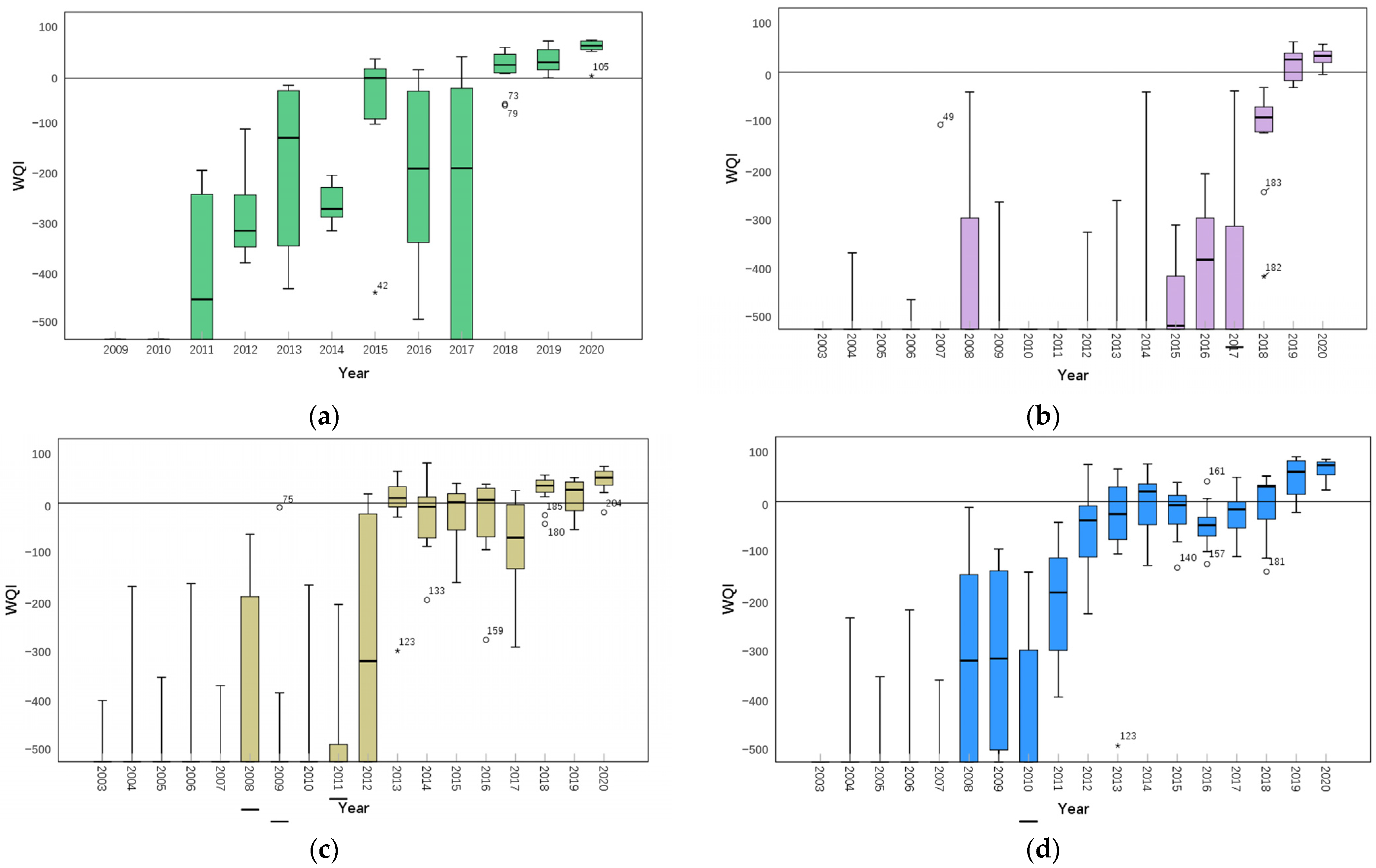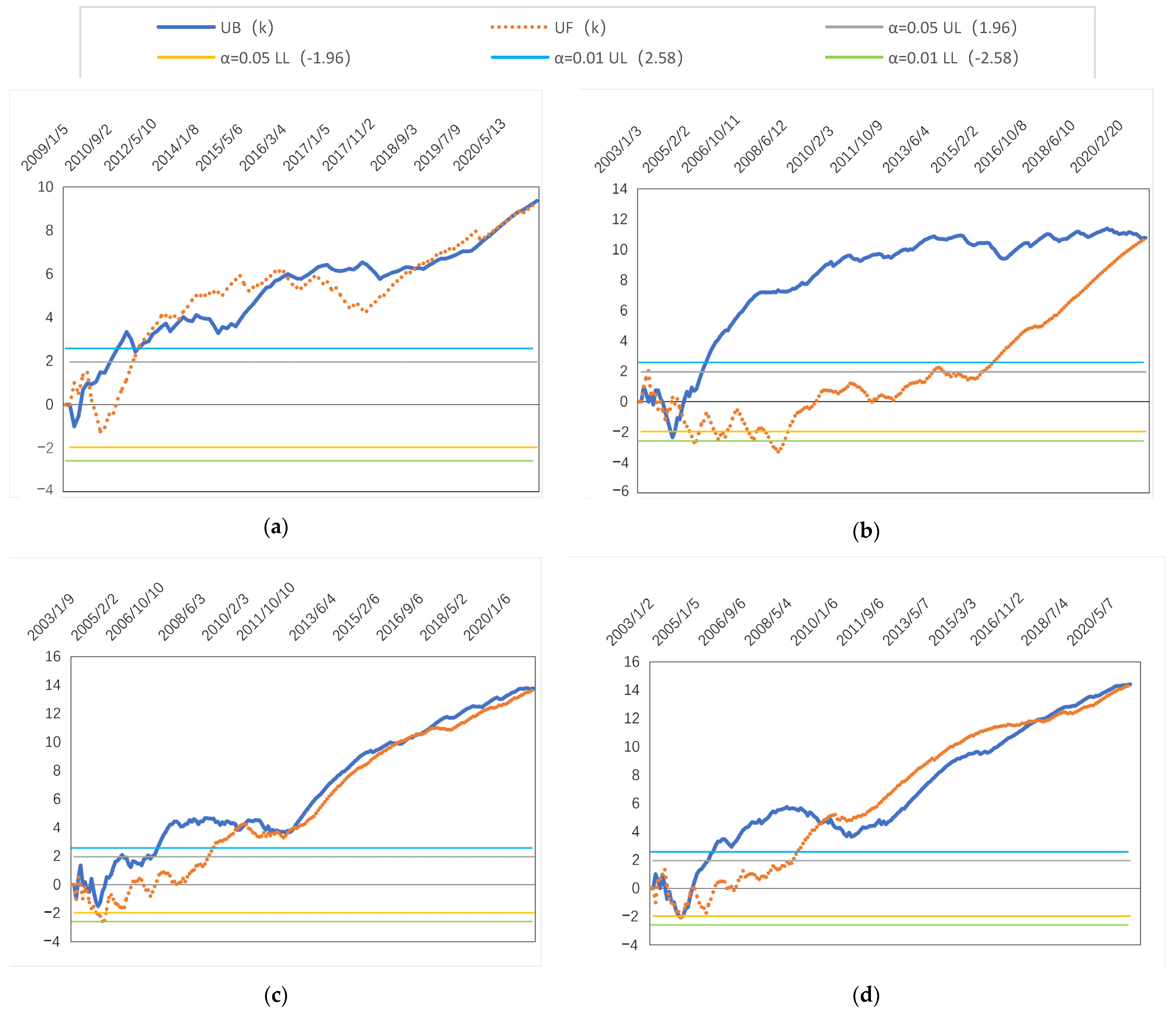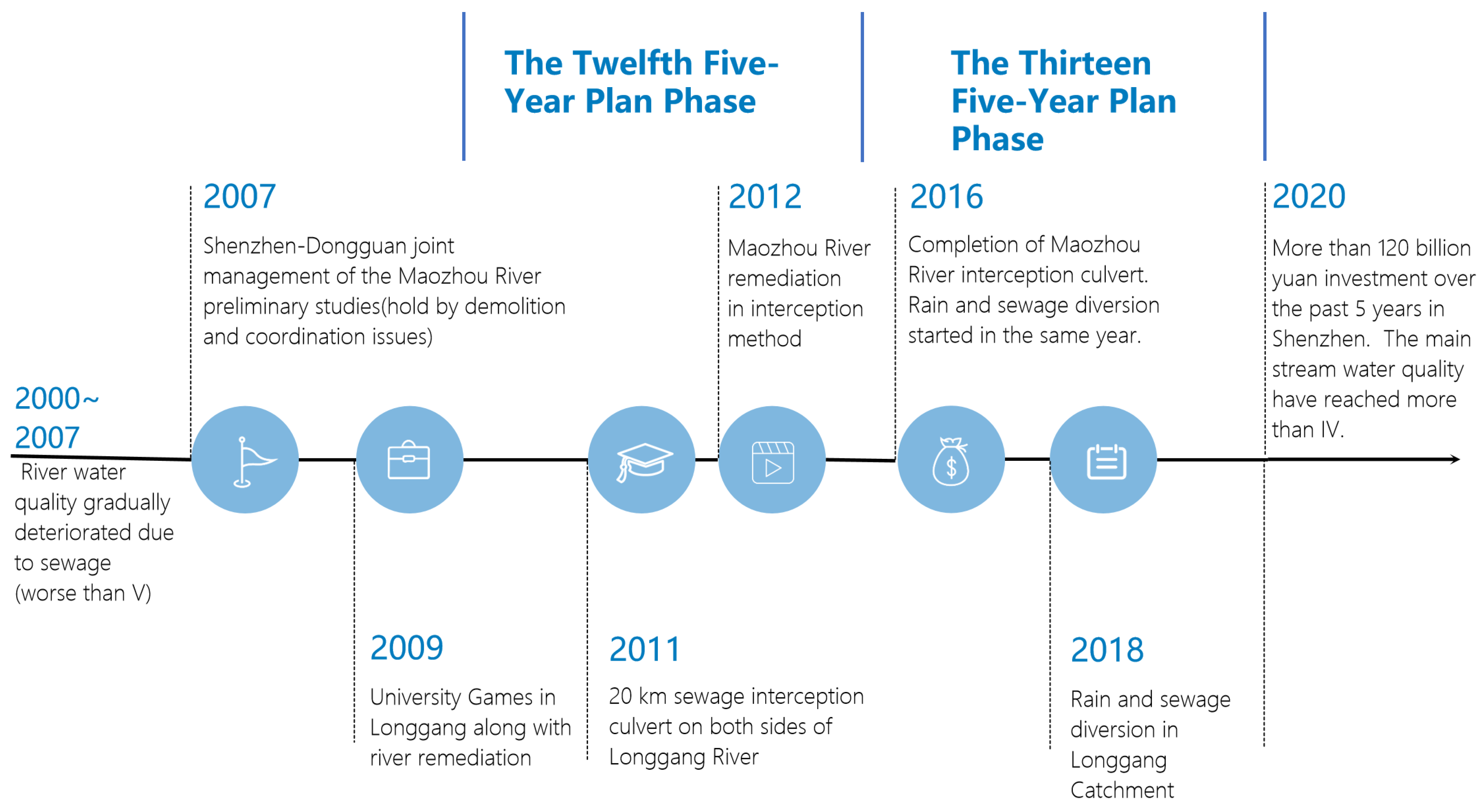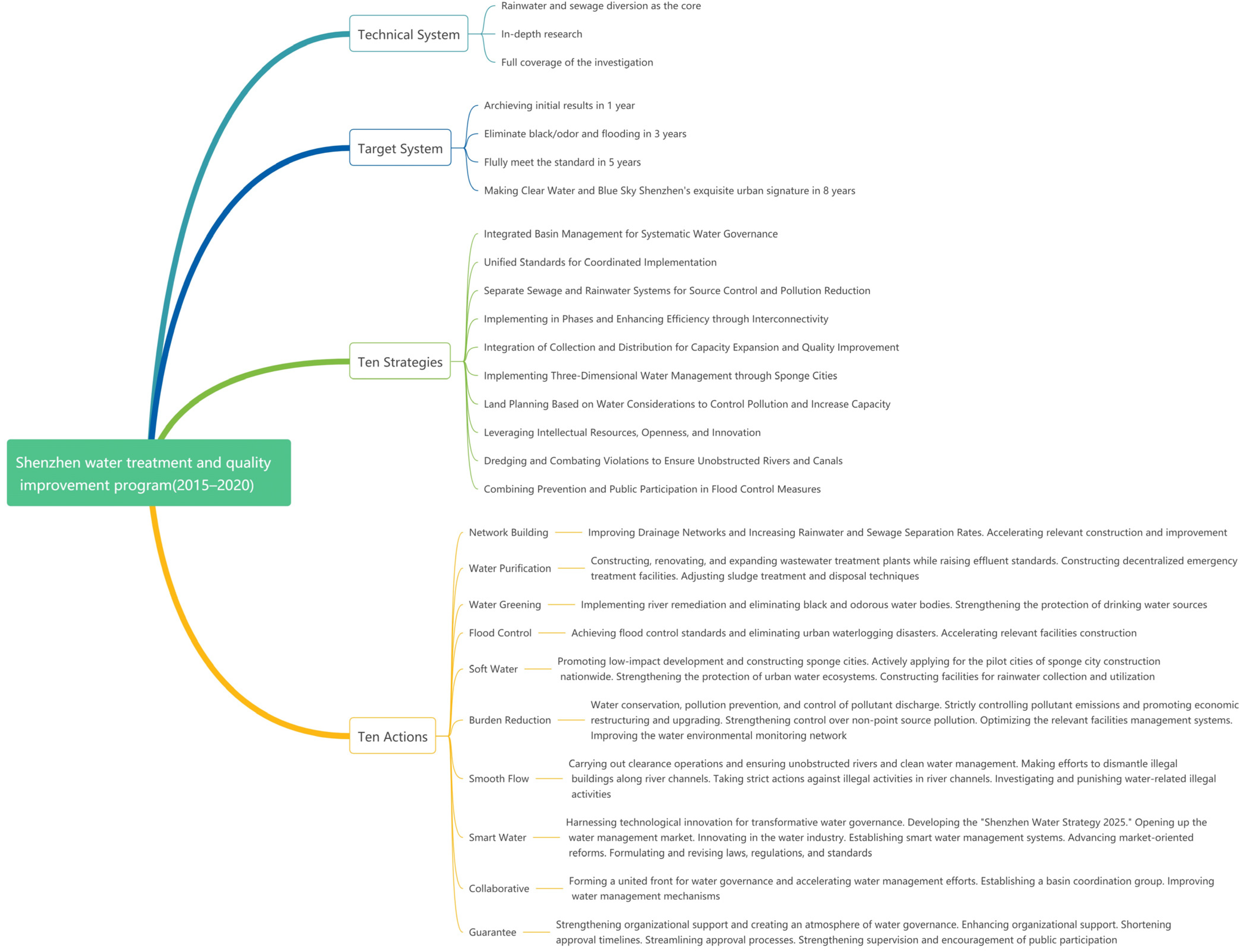Historical Trends and Driving Forces of River Water Quality Improvement in the Megacity Shenzhen, China
Abstract
1. Introduction
2. Research Area and Data
2.1. Research Area
2.2. Monitoring Campaign
- (1)
- Monitoring sections
- (2)
- Monitoring period and frequency
- (3)
- Water quality indicators and analysis method
3. Methodology
3.1. M-K Trend Test
3.2. Comprehensive Pollution Index of Water Quality (WQI-DET)
4. Results and Discussion
4.1. Overall Water Quality of Rivers
4.2. Characteristics of Interannual Variation in Water Quality
4.3. Increasing Trend of the Composite Water Quality Index
4.4. WQI Mutation Test
4.5. Driving Factor Analysis
- (1)
- Failure of ‘Regional Point Source Intercept’ Attempt (2000~2007)
- (2)
- Diversion sewage Collection and Interception (2008~2015)
- (3)
- Sewage plant upgrade and water reuse (2016~2020)
5. Conclusions
- (1)
- The WQI-DET index method takes into consideration both the current and historical water quality of a body of water, which allows for trend analysis and the identification of patterns in water quality evolution over time. The WQI-DET index method is effective for analyzing the historical process of black odor water bodies, especially in tracking change point when effective actions taken which can be applied to other cities to analyze systematic reviews after black odor treatment.
- (2)
- The water quality characteristics of the Maozhou River and Longgang River basins differ significantly. Generally, the water quality upstream of Maozhou River is better and more stable. The difference between upstream and downstream water quality in Longgang River is minor, and better than downstream of Maozhou River but worse than upstream of Maozhou River. The improvement trend of Longgang River is more consistent.
- (3)
- The water quality of Maozhou River has been improving since 2004. However, due to the comprehensive management project that began in 2015–2016, the comprehensive pollution index has inevitably declined after the rapid improvement and stabilization in 2020.
- (4)
- The trend of water quality changes in Longgang River was not apparent before 2008. Between 2008 and 2011, the comprehensive pollution index first decreased and then increased due to the start of the interception project, and then steadily increased. In 2017, there was a rapid improvement and stabilization due to fluctuations caused by the comprehensive management project.
- (5)
- The main driving factor for the improvement of water quality in Maozhou River and Longgang River is the large-scale water environment improvement project and its sequence. River remediation and interception culverts serve as a defensive line against sewage entering the river in the first place. Subsequently, large-scale sewage collection effectively controls pollution sources. Finally, the water replenishment system of wastewater treatment plants provides the river with a clean water source. After the systematic treatment, the water quality of the two rivers steadily reached the III standard. However, the water quality still cannot meet the standards of surface water class II, due to effluent water quality of the wastewater treatment plant and non-point source pollution.
Author Contributions
Funding
Data Availability Statement
Acknowledgments
Conflicts of Interest
References
- Deng, G.; Yao, X.; Jiang, H.; Cao, Y.; Wen, Y.; Wang, W.; Zhao, S.; He, C. Study on the Ecological Operation and Watershed Management of Urban Rivers in Northern China. Water 2020, 12, 914. [Google Scholar] [CrossRef]
- Scanlon, B.R.; Fakhreddine, S.; Reedy, R.C.; Yang, Q.; Malito, J.G. Drivers of Spatiotemporal Variability in Drinking Water Quality in the United States. Environ. Sci. Technol. 2022, 56, 12965–12974. [Google Scholar] [CrossRef] [PubMed]
- Lokhande, S.; Tare, V. Spatio-temporal trends in the flow and water quality: Response of river Yamuna to urbanization. Environ. Monit. Assess 2021, 193, 117. [Google Scholar] [CrossRef] [PubMed]
- Li, C.; Wang, Z.; Zhang, H.; Ning, T.; Huang, S.; Yan, M.; Liu, J. Comprehensive renovation scheme and target accessibility analysis of Dongjiao River in Fuzhou. Water Wastewater Eng. 2020, 56, 654–658+665. [Google Scholar]
- Wang, S.; Chen, L.-Y.; Sun, X. From rainwater and sewage interception to separation system combined with low impact development reconstruction in urban built-up area: A water quality constrained scenario stimulation and programming. China Environ. Sci. 2017, 37, 383–392. [Google Scholar]
- Huang, Y.; Wang, Y. River Water Quality Degradation in Shenzhen City and Its Influencing Mechanisms. China Rural. Water Hydropower 2007, 7, 10–13. [Google Scholar]
- Xu, H.; Xiao, D. The Effect of Greenway in Optimizing Town Space—A Case Study of Maozhou River Watershed in Shenzhen. South Archit. 2014, 106–109. [Google Scholar]
- Zhang, S.; Zhang, H.; Xin, C.; Nan, Z.; Li, Z. A method for characterizing trends and morphological changes of hydrological series. Water Resour. Prot. 2019, 35, 58–67. (In Chinese) [Google Scholar]
- Xue, Q.; Liu, J. Methods and Analyses of Water Pollution Comprehensive Index Assessment. Environ. Eng. 2004, 5, 64–66+69. [Google Scholar]
- Dong, X.; Mei, K.; Shang, X.; Huang, S.; Huang, H. Analysis of Variation Trend of Water Quality Based on Mann-Kendall Test and Rescaled Range Analysis. J. Ecol. Rural. Environ. 2016, 32, 277–282. [Google Scholar]
- Ha, D.W.; Baek, J.; Choi, J.Y.; Kim, B.-I.; Lee, Y.; Shin, D.S. Water quality trend and pollutant load and source analysis of Tamjin River water system. Environ. Monit. Assess 2023, 195, 744. [Google Scholar] [CrossRef] [PubMed]
- Huang, J.; Zhang, Y.; Arhonditsis, G.B.; Gao, J.; Chen, Q.; Wu, N.; Dong, F.; Shi, W. How successful are the restoration efforts of China’s lakes and reservoirs? Environ. Int. 2019, 123, 96–103. [Google Scholar] [CrossRef] [PubMed]
- Wu, J.; Xue, C.; Tian, R.; Wang, S. Lake water quality assessment: A case study of Shahu Lake in the semi-arid loess area of northwest China. Environ. Earth Sci. 2017, 76, 232. [Google Scholar] [CrossRef]
- Gao, W.; Chen, Y.; Xu, M.; Guo, H.; Xie, Y. Trend and driving factors of water quality change in Lake Fuxian (1980–2011). J. Lake Sci. 2013, 25, 35–642. [Google Scholar]
- Li, M.; Ma, S.; Gao, J.; Zhu, J.; Wang, Y. Study on pollution source weight and control strategy of river interception river in built-up area. Water Wastewater Eng. 2019, 5, 51–56. [Google Scholar]
- Yu, W.; Liu, H. Correlation Between Urbanization and Climate Change of Shenzhen in Nearly 35 Years. J. South China Norm. Univ. 2019, 50, 7. [Google Scholar]
- Cai, W.; Chen, Z.; Pan, Z. Variation Characteristics of Air Temperautre and Precipitaion of Shezhen over the Past 63 Years. Guangdong Meteorol. 2017, 39, 6–9. [Google Scholar]
- Wang, L.; Wang, J. Comprehensive water treatment methods and practices in highly urbanized areas. China Water Resour. 2020, 892, 6. [Google Scholar]
- Zhu, A.; Chen, J.; Jjiang, T.; Li, K.; Gao, Q.; Chen, Y.; Zhong, J. Spatial and Seasonal Variation of Nutrients Transportation in the Maozhou Estuary of Shenzhen, Guangdong. Trop. Geogr. 2015, 35, 298–305. [Google Scholar]






| Rivers | Cross-Section | Number | Longitude (E) | Latitude (N) | Items |
|---|---|---|---|---|---|
| Maozhou River | Loucun | S1 | 113.911352 | 22.78217 | DO, COD, NH3-N, TP, a-SAA |
| Yanchuan | S2 | 113.849599 | 22.79618 | ||
| Longgang River | Dishan Village | S3 | 114.289368 | 22.741019 | |
| Xiapi | S4 | 114.349678 | 22.767369 |
| Variables | Unit | Significance |
|---|---|---|
| DO | mg/L | It indicates the water’s capacity to support aquatic organisms and their ability to carry out essential biological processes. |
| COD | mg/L | It indicates the presence of substances that can consume oxygen and potentially degrade water quality. |
| NH3-N | mg/L | Elevated levels of ammonia can be indicative of organic pollution, excessive fertilization, or improper wastewater treatment. |
| TP | mg/L | Phosphorus is a nutrient that can promote excessive growth of algae and aquatic plants, leading to eutrophication. |
| a-SAA | mg/L | The presence of anionic surfactants in water indicates the input of domestic or industrial wastewater. |
| Rivers | Cross-Section | Number | Items | Max (mg/L) | Min (mg/L) | Year of Achieving Class III |
|---|---|---|---|---|---|---|
| Maozhou River | Loucun | S1 | DO | 7.54 | 0.85 | 2012 |
| COD | 176.02 | 10.58 | 2018 | |||
| NH3-N | 72.1 | 0.46 | 2018 | |||
| TP | 9.41 | 0.14 | 2020 | |||
| a-SAA | 0.95 | ND | 2012 | |||
| Yanchuan | S2 | DO | 6.02 | 0.77 | 2018 | |
| COD | 156.89 | 12.83 | 2018 | |||
| NH3-N | 30.58 | 0.71 | 2019 | |||
| TP | 4.8 | 0.28 | 2020 | |||
| a-SAA | 3.1 | ND | 2017 | |||
| Longgang River | Dishan Village | S3 | DO | 6.83 | 2.97 | 2012 |
| COD | 93.02 | 13.33 | 2013 | |||
| NH3-N | 21.43 | 0.88 | 2013 | |||
| TP | 5.34 | 0.18 | 2020 | |||
| a-SAA | 1.715 | ND | 2013 | |||
| Xiapi | S4 | DO | 7.02 | 2.69 | 2011 | |
| COD | 79.03 | 10.13 | 2012 | |||
| NH3-N | 19.86 | 0.36 | 2017 | |||
| TP | 5.25 | 0.14 | 2020 | |||
| a-SAA | 1.598 | ND | 2012 |
| Rivers | Cross-Section | Number | WQI z | WQI Slope |
|---|---|---|---|---|
| Maozhou River | Loucun | S1 | 9.318 *** | 21.904 |
| Yanchuan | S2 | 9.772 *** | 11.165 | |
| Longgang River | Dishan Village | S3 | 5.519 *** | 8.746 |
| Xiapi | S4 | 38.378 *** | 8.101 |
| Watershed | Project | Investment (Million RMB) | ||
|---|---|---|---|---|
| The 11th Five-Year Plan (2006–2010) | The 12th Five-Year Plan (2011–2015) | The 13th Five-Year Plan (2016–2020) | ||
| Maozhou River | River Remediation | 686.5 | 1733.03 | 6163.2 |
| Sewage Collection | 499.27 | 3192.824 | 362.48 | |
| Sewage Plant Upgrade | 515.75 | 320.05 | 1989.28 | |
| Riverbed Sediment Treatment | 357.41 | -- | -- | |
| water reuse | 0 | 230.44 | -- | |
| Longgang River | River Remediation | 0 | 1367.2173 | 1640.54 |
| Sewage Collection | 150 | 1880.722 | 95.88 | |
| Sewage Plant Upgrade | 588.26 | 88.54 | 1742.7 | |
| Riverbed Sediment Treatment | 285.93 | -- | -- | |
| Water reuse | 0 | 68.43 | -- | |
Disclaimer/Publisher’s Note: The statements, opinions and data contained in all publications are solely those of the individual author(s) and contributor(s) and not of MDPI and/or the editor(s). MDPI and/or the editor(s) disclaim responsibility for any injury to people or property resulting from any ideas, methods, instructions or products referred to in the content. |
© 2023 by the authors. Licensee MDPI, Basel, Switzerland. This article is an open access article distributed under the terms and conditions of the Creative Commons Attribution (CC BY) license (https://creativecommons.org/licenses/by/4.0/).
Share and Cite
Sun, X.; Wu, Q.; Jiang, J.; Lin, K. Historical Trends and Driving Forces of River Water Quality Improvement in the Megacity Shenzhen, China. Water 2023, 15, 2283. https://doi.org/10.3390/w15122283
Sun X, Wu Q, Jiang J, Lin K. Historical Trends and Driving Forces of River Water Quality Improvement in the Megacity Shenzhen, China. Water. 2023; 15(12):2283. https://doi.org/10.3390/w15122283
Chicago/Turabian StyleSun, Xiang, Qingping Wu, Jiping Jiang, and Kairong Lin. 2023. "Historical Trends and Driving Forces of River Water Quality Improvement in the Megacity Shenzhen, China" Water 15, no. 12: 2283. https://doi.org/10.3390/w15122283
APA StyleSun, X., Wu, Q., Jiang, J., & Lin, K. (2023). Historical Trends and Driving Forces of River Water Quality Improvement in the Megacity Shenzhen, China. Water, 15(12), 2283. https://doi.org/10.3390/w15122283








